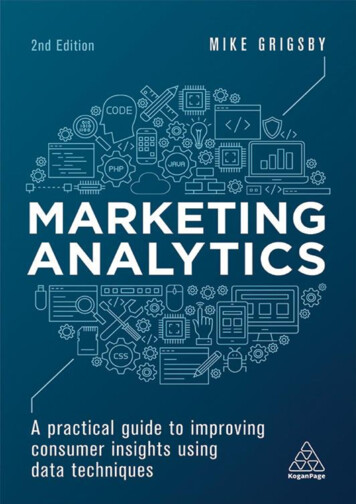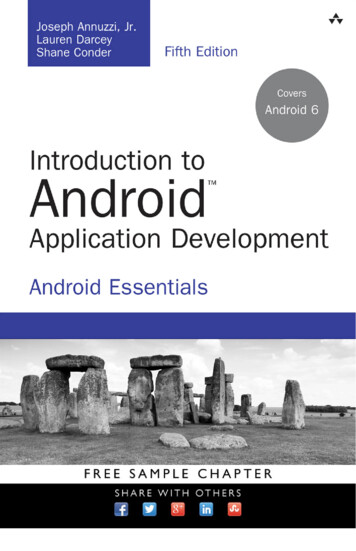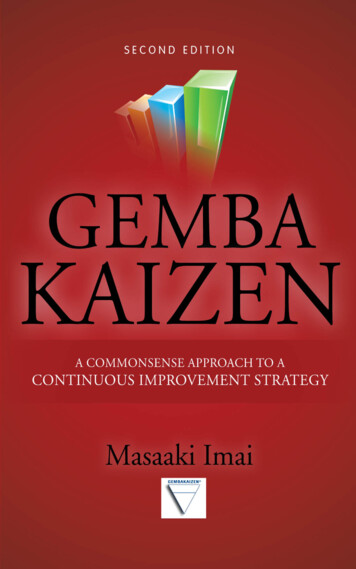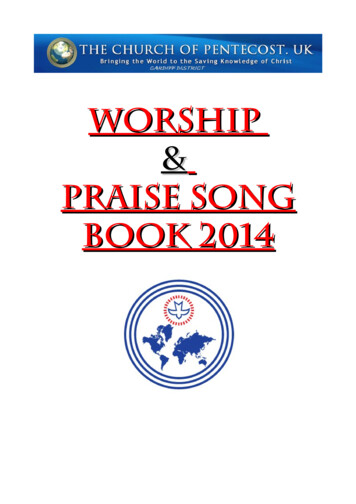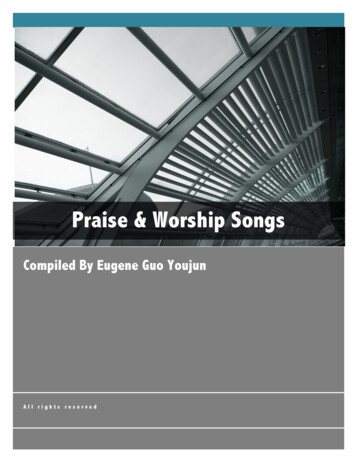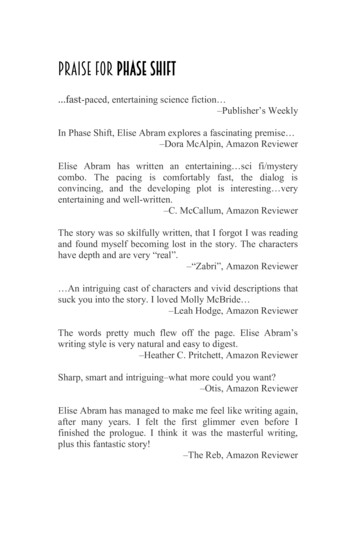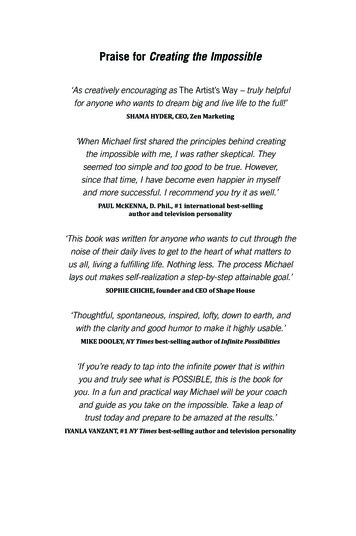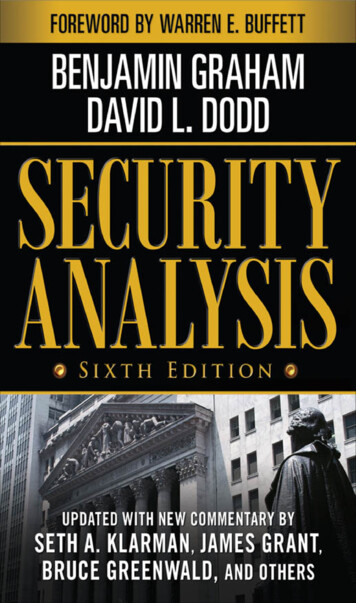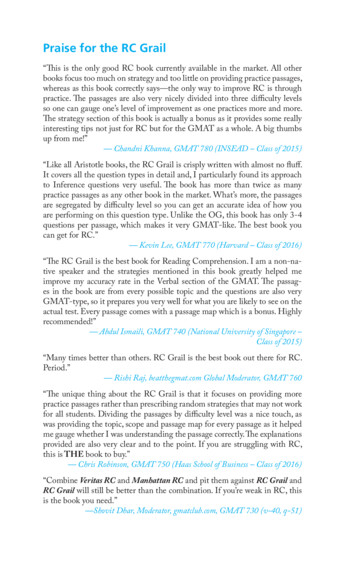
Transcription
Praise for the RC Grail“This is the only good RC book currently available in the market. All otherbooks focus too much on strategy and too little on providing practice passages,whereas as this book correctly says—the only way to improve RC is throughpractice. The passages are also very nicely divided into three difficulty levelsso one can gauge one’s level of improvement as one practices more and more.The strategy section of this book is actually a bonus as it provides some reallyinteresting tips not just for RC but for the GMAT as a whole. A big thumbsup from me!”— Chandni Khanna, GMAT 780 (INSEAD – Class of 2015)“Like all Aristotle books, the RC Grail is crisply written with almost no fluff.It covers all the question types in detail and, I particularly found its approachto Inference questions very useful. The book has more than twice as manypractice passages as any other book in the market. What’s more, the passagesare segregated by difficulty level so you can get an accurate idea of how youare performing on this question type. Unlike the OG, this book has only 3-4questions per passage, which makes it very GMAT-like. The best book youcan get for RC.”— Kevin Lee, GMAT 770 (Harvard – Class of 2016)“The RC Grail is the best book for Reading Comprehension. I am a non-native speaker and the strategies mentioned in this book greatly helped meimprove my accuracy rate in the Verbal section of the GMAT. The passages in the book are from every possible topic and the questions are also veryGMAT-type, so it prepares you very well for what you are likely to see on theactual test. Every passage comes with a passage map which is a bonus. Highlyrecommended!”— Abdul Ismaili, GMAT 740 (National University of Singapore –Class of 2015)“Many times better than others. RC Grail is the best book out there for RC.Period.”— Rishi Raj, beatthegmat.com Global Moderator, GMAT 760“The unique thing about the RC Grail is that it focuses on providing morepractice passages rather than prescribing random strategies that may not workfor all students. Dividing the passages by difficulty level was a nice touch, aswas providing the topic, scope and passage map for every passage as it helpedme gauge whether I was understanding the passage correctly. The explanationsprovided are also very clear and to the point. If you are struggling with RC,this is THE book to buy.”— Chris Robinson, GMAT 750 (Haas School of Business – Class of 2016)“Combine Veritas RC and Manhattan RC and pit them against RC Grail andRC Grail will still be better than the combination. If you’re weak in RC, thisis the book you need.”—Shovit Dhar, Moderator, gmatclub.com, GMAT 730 (v-40, q-51)
WileyThe ONLY book you need to ace the GMAT Reading ComprehensionGMAT ReadingComprehension Grail2017POCKETBOOKNOT FOR SALESecrets to reading RC Passages quicklyyet effectivelyQR Codes to access ‘Expert Speak’ videos70Wide range of Passages—Feminism,American History, Philosophy, Science, etc.Passages divided into Low, Medium, & High Difficulty Levels References to the 2017, 2016 and 2015 editions of the Official Guide for GMATReview and the 2017 and 2016 editions of the Official Guide for Verbal ReviewGMAT and GMAC are registered trademarks of the Graduate ManagementAdmission Council which neither sponsors nor endorses this product
4 GMAT Reading Comprehension Grail 2017 Pocket BookThe GMAT Reading Comprehension Grail 2017 Pocket Bookprovides you with a glimpse of the Aristotle GMAT ReadingComprehension Grail 2017—the only book you need to ace theReading Comprehension questions in the GMAT Verbal Section.The Pocket Book includes a selection of some key sections andabridged chapters of the main book, to help you understand theunique structured approach adopted to teach sentence correction forGMAT.For complete content coverage, please refer to the book GMATReading Comprehension Grail 2017.
Introduction 5ContentsSECTION 1: IntroductionAbout GMAT Reading Comprehension Grail 201757About the GMAT12SECTION 2: Basics of Reading Comprehension17SECTION 3: Reading Comprehension Question Types 25Global Questions27SECTION 4: Strategies to Tackle GMAT RC Questions 33SECTION 5: RC Practice Passages39Low Difficulty Passages40Medium Difficulty Passages45High Difficulty Passages50Answers and Explanations52
SECTION 1Introduction
8 GMAT Reading Comprehension Grail 2017 Pocket Book
Introduction 9About GMAT Reading Comprehension Grail2017Reading Comprehension (RC) is one of the key problem areasfor most students appearing for the GMAT. What makes RCespecially difficult is that, unlike Sentence Correction, there are nospecific rules that you can use to improve your accuracy in ReadingComprehension overnight.It really helps if you have been in the habit of reading because thenyou already have a comfort level when it comes to reading andcomprehending text; you are also familiar with the various nuancesof the English language and so you will be better able to identifythe subtle hints provided in the passages by the author, which wouldfurther help you answer the questions judiciously.However, many students are really not in the habit of reading. Forsuch students, RC needs to be improved in the old fashioned way—with lots and lots of practice. While there are some basic strategiesthat will be discussed in the GMAT Reading Comprehension Grail2017 that will surely help you improve your scores drastically, thestress will be on practicing as many passages as you can. For thisreason we have provided 60 practice passages in this book so thatyou can perfect the strategies detailed in the book on these passages.
10 GMAT Reading Comprehension Grail 2017 Pocket BookSections in the Book at a GlanceSection 1: About the GMAT gives you a broad overview ofthe GMAT—test format, duration, scoring, andmore.Section 2: Diagnostic Test administers a diagnostic testthat will help you assess your current level ofcompetence in Reading Comprehension beforeyou go through the concepts and strategies in thisbook.Section 3: Brings you up to speed with all the importantconcepts relevant to GMAT Reading Comprehension.Section 4: Discusses the major question types tested onGMAT Reading Comprehension and providesstrategies on how to approach each of these.Section 5: Provides all the important strategies and tipsnecessary to effectively tackle GMAT ReadingComprehension.Section 6: Practice Set contains a Reading Comprehensionpractice set with 60 passages divided into threedifficulty levels—Easy, Medium, and Highdifficulty.Section 7: Quick Recall provides a Quick recap of all theimportant concepts and rules covered in this book.This section saves you the trouble of taking notesso you can concentrate on understanding theconcepts. Go through this section before everypractice test that you take.
Introduction 11Special FeaturesThe OG for GMAT Review 2017, 2016 and 2015, andGMAT Verbal Review 2017 and 2016 ReferencesFor most of the concepts covered in this book, you will also find OGquestion references that will provide you with the question numberof similar questions present in the OGs 2015, 2016 and 2017, andalso in the OG Verbal Review (VR) 2016 and 2017. As a result, youcan see how the concepts explained in this book are actually testedon the GMAT.Access Videos using QR CodesThe Sentence Correction Grail includes ‘Expert Speak’ videos andother exclusive training content that you can easily access throughan app—on your smartphone or tablet—using the QR codesprovided at various locations throughout the book. This will furtherhelp reinforce your understanding of the concepts.To access the videos: Step 1 – Download and Install the App on your Smartphone /tabletTo access the videos and other content, you will need to downloadthe *Wiley Test Prep App from either Apple’s App store (iTunes)or Google Play Store and install it on your Smartphone or tablet. For Apple devices: Go to Apple’s App Store and search forWiley Test Prep. Locate the app from the displayed results andclick on Install. For Android devices: Go to Google Play Store and search forWiley Test Prep. Locate the app from the displayed results andclick on Install.While installing the app, you will be asked to key in the uniqueregistration code printed on the last page of the GMAT SentenceCorrection Grail 2017 book. This registration code will work onlyonce and on only one device. Step 2 – Scan the QR codes and access your training contentOnce you have installed the app, you can access the videos andtraining content on your mobile device by scanning the QR codesprovided throughout this book.* The videos provided in this sample can be accessed using any generic QR code scanner.
12 GMAT Reading Comprehension Grail 2017 Pocket Book Open the app and click on the Scan QR Code menu optionavailable under the top right corner menu. This will start thescanning activity for that particular QR code.Focus the camera of your mobile device over the desired QRcode given in the book, and wait for a few seconds till you hearthe ‘tick’ sound. Once the QR code has been scanned and foundvalid, you will be directed to the associated video/content.Repeat the process for all other QR codes to access theirassociated videos/content. Note:1. The app login will be valid for 12 months from the date ofactivation.2.3.The app login is valid only for one device.In case of any difficulty, please reply to the confirmation emailthat you received when you registered for the app.Clearing your Doubts/QueriesThe purchase of the GMAT RC Grail 2017 provides you directaccess to the experts who have written this book. So, in case thereis any concept or question discussed in this book that you do notunderstand, please put up the same on the Forums section of ourwebsite: www.aristotleprep.com. Our experts will respond to youwithin 48 hours and help clear all your doubts.Learning ToolsBeyond the OG References and ExpertSpeak videos, the GMATRC Grail 2017 includes some key learning tools which will help youfind the relevant preparation material in an organized and easy toaccess format. Some of these include: Important Tips: Highlights key tips and strategiesTo sum it up: Lists the key points at the end of each segmentfor easy recallTo sum it up, we have tried to make the Aristotle GMAT ReadingComprehension Grail 2017 as comprehensive and, at the same time,as student-friendly as possible. We are sure you will find this bookuseful in your GMAT preparations.Good Luck and Study Hard!The Aristotle Prep Team
Introduction 13Complete Table of Contents ofGMAT Reading Comprehension Grail 2017Section 1: About the GMATSection 2: Diagnostic TestSection 3: Basics of Reading ComprehensionSection 4: Reading Comprehension Question Types1. Global Questions2.Detail Questions4.Miscellaneous Questions3.Inference Questionsa. Function Questionsb. Vocabulary-in-Context Questionsc. Critical Reasoning type QuestionsSection 5: Strategies to Tackle GMAT ReadingComprehensionSection 6: Practice Passages1.Low Difficulty Passages3.High Difficulty Passages2.4.Medium Difficulty PassagesAnswers and ExplanationsSection 7: Quick Recall
14 GMAT Reading Comprehension Grail 2017 Pocket BookAbout the GMATWhat is the GMAT?The GMAT stands for Graduate Management Admission Test. Itis an exam required for admissions to MBA programs in the US andin other top business schools across the world. It is also required foradmission to a few Masters and PhD courses.It is important for you to know that the GMAT is a computeradaptive test. This means that the difficulty level of the nextquestion in a section is determined by your performance on theprevious questions. Therefore, as you progress through the test, thesoftware continuously tries to evaluate your performance and adaptsthe difficulty level of the next questions to your performance onthe previous ones. For this reason, you cannot skip or go back toattempted questions on the test.What does the GMAT consist of?The GMAT consists of four sections, which appear in the fixed ordergiven below.SectionTimeQuestionsAnalysis of an Argument Essay30 minutes1Integrated Reasoning30 minutes12Quantitative75 minutes37Verbal75 minutes41There are two optional 8-minute breaks during the GMAT. The firstone is after the Integrated Reasoning section and the second one isafter the Quantitative section.Integrated Reasoning questions can be further dividedinto the following four question types: Graphics InterpretationTwo-Part AnalysisTable AnalysisMulti-Source Reasoning
Introduction 15Quantitative questions can be further divided into thefollowing two question types: Problem SolvingData SufficiencyVerbal questions can be further divided into thefollowing three question types: Sentence CorrectionCritical ReasoningReading ComprehensionHow am I scored on the GMAT?The GMAT scores range from 200–800. A score of 200 is the lowestyou can get and a score of 800 is the highest. For each section, youget something called a scaled score and there is also a percentilescore corresponding to a scaled score. AWA – This section is scored on a scale of 0–6 in half-pointincrements.Integrated Reasoning – This section is scored on a scale of 0–8in one-point incrementsQuantitative and Verbal – These two sections are scored on ascale of 51. The GMAC does not reveal how exactly this scoreis calculated, but we do know for sure that the difficulty level ofthe questions you get correct/incorrect plays an important rolein determining your final score on the test.When can I take the GMAT? How many times is itconducted in a year?The GMAT can be taken at any time of the year. You sign up to takethe exam INDIVIDUALLY, whenever you are free. The only thingto consider is whether the date, on which you want to take the exam,is available at the test centre of your choice. This is important in bigcities such as New York, Los Angeles, Beijing, New Delhi, and so on,where the number of test takers is quite high and you may have tobook a slot usually a month or two before your exam date.
16 GMAT Reading Comprehension Grail 2017 Pocket BookHow do I register for the GMAT and how much is theexam fee?You can register for the GMAT by logging on to http://www.mba.com/ and then going to the registration page. The GMAT exam feeis 250, as of 2016.What should I do after taking my GMAT?If your actual GMAT score is lower than what you would like it tobe, you can always retake the test. However, if you feel you have got asatisfactory score, it is time to start working on your business schoolapplications. You will need to start off by shortlisting schools basedon criteria such as your desired field of study, your GMAT score, thecountry or region you want to be in, etc. At Aristotle Prep, we have afull fledged counselling division that can assist you with the businessschool application process. You can go through www.aristotleprep.com for details.How do I prepare for the GMAT?As with most other similar tests, you can start off by revising thebasics of the quant and verbal concepts that are tested on theGMAT. Books such as this one are one of the best ways of doing so.Once you have completed your basics, it’s time to apply all thatlearning on actual GMAT questions. At this point, you will alsowant to get your hands on the The Official Guide for GMAT Review(OG) set of books as these are the only source of actual GMATquestions.Once you have completed all the questions in the OG, you need tostart taking a few timed online practice tests. The GMAC providesyou two such practice tests (called the GMATPrep) for free on theofficial GMAT website: www.mba.com. You can access two more ofthese tests by purchasing them separately.Once you start scoring within 20-30 points of your desired score inthe GMATPrep tests, it is time for you to book your test date andtake the real GMAT.While you need to work hard to get a good GMAT score, you alsoneed to work smart. For in-depth discussion on some generalsmart GMAT test taking strategies, refer to the complete bookGMAT Reading Comprehension Grail 2017.
SECTION 2Basics of ReadingComprehension
Basics of Reading Comprehension 19Basics of Reading ComprehensionThe Reading Comprehension (RC) section of the GMAT will testyour ability to read and comprehend complex text in a limited timeperiod. You will get four RC passages on the GMAT with a total of13-14 questions. The RC passages will not come all together; ratherthey will appear intermingled with Sentence Correction (SC) andCritical Reasoning (CR) questions. Usually, you will get two shortpassages (200-300 words each) and two long passages (350-450words each). The short passages usually contain 3 questions eachand the long passages contain 4 questions each. You will only seeone question on your screen at a time.Keep in mind that, while the passages themselves are adaptive (thatis, if you are doing well on the test you will get a more difficultpassage and vice versa), the questions within a passage do not changein difficulty level. So, if you get an easy question after a tough one, itdoes not necessarily mean that you got the earlier question wrong.How Much Time Should You Spend on Each Passage?The GMAT is, to a large extent, a test of time management. Youmust divide your time intelligently across question types and makesure that you stick to this time limit. Section 1 of the GMAT Reading Comprehension Grail 2016 gives a very effective time management strategy that we call the 8/15 rule.Coming back to how much time you should spend on each RC passage, we recommend that you spend around 3-4 minutes to read thepassage and 1-1.5 minutes to answer each question thereafter. So, ashort passage should take you around 7 minutes to complete and along passage should take you around 9 minutes to complete. (This isassuming that you take an average of 1 minute per Sentence Correctionquestion and 2 minutes per Critical Reasoning question. To know how todo this, refer to the GMAT Sentence Correction Grail 2017 and GMATCritical Reasoning Grail 2017.)If you are wondering whether this is too little time, let us assure youthat this is more than enough time. In our experience, most students(even average ones) successfully manage to complete RC passagesin around 7-7.5 minutes. It is on Sentence Correction and CriticalReasoning questions that they end up spending too much time!
20 GMAT Reading Comprehension Grail 2017 Pocket BookNature of PassagesThe passages that you see on the GMAT will primarily be from thefollowing subject areas: Physical Sciences Social Sciences Humanities Business and EconomicsThe passages will not always be interesting or fun to read; as a matter of fact some of them may be downright boring and difficult tounderstand. The language of the passages will be similar to whatyou are likely to see in key publications such as The Economist andThe Wall Street Journal. Generally, passages from Physical Sciencesor Business and Economics subject areas are more detail-orientedand easier to understand than passages from Social Sciences andHumanities, which tend to be of an abstract nature.The problem most students face on RC is that they have to gothrough text from areas they aren’t conversant with, and answerquestions based on this. The moment you see a passage from anunfamiliar area such as American History or Women’s Suffrage,you immediately start telling yourself that you will not do well onthis passage because you have no idea about the subject area. If youstart with this negative thought process, things are likely to only godownhill.Please keep in mind that you are not expected to have any priorknowledge of the topic in the first place. All the information thatyou need to answer the questions is given to you in the passage. Youjust need to comprehend the passage and select the correct answerfrom the options provided. In fact, there is a negative aspect of getting passages from your comfort area which you will see in Section 5of the GMAT Reading Comprehension book.Examples of non-countable nouns: love, happiness, information, news furniture, luggage, sugar, butter, water electricity, power, money
Basics of Reading Comprehension 21How NOT to Approach RC PassagesWhenever we read some text, it is human tendency to focus on thefacts provided. We tend to obsess over specific details, numbers, anddates but in the process we end up missing out on the big picture,which provides the answer to the question ‘WHY’. Why has theauthor provided these figures or details? This is the purpose of theauthor in writing this passage. If you concentrate on the details andmiss out on this ‘WHY’ aspect, then you will always struggle to answer RC questions correctly.This is because most questions will not directly ask you somethingthat is clearly mentioned in the passage; rather the questions willbe more roundabout or indirect in nature. The answer to most ofthe questions will not be clearly stated in the passage, so it does notmake sense to spend valuable time trying to absorb all the detailsmentioned in the passage.Make a Passage MapA good way of approaching a passage is to make a map of the passage. A passage map is nothing but one or two lines for every paragraph in the passage highlighting why the author has written thatparagraph. Note that the passage map does not have to highlightwhat the author has written but rather why has he written what hehas written, which means that the points in your passage map shouldalways start with verbs such as describe, explain, praise, criticize,condemn, etc. Most of the time you will find this information ineither the first or the last sentence of each paragraph. Students oftentend to focus on the middle part of paragraphs (which contains allthe details) so please make a conscious effort to go back and read thefirst and the last sentence of every paragraph so as to keep a perspective of why the author is writing what he is writing.To understand this process better, let’s try to make a passage mapusing the following passage, adapted from the Cambodian Journal ofNatural History:The masked finfoot Heliopais personata is a rarewaterbird with a peculiar appearance. It is the onlymember of the family Heliornithidae in Asia, andthe only member of its genus. This species is patchilydistributed within a range extending from NorthernIndia to Vietnam, and southwards to Peninsular
22 GMAT Reading Comprehension Grail 2017 Pocket BookMalaysia and Indonesia. The global population of thisbird is considered in steep decline.Enigmatic, both historically and recently, little isknown of the ecology, distribution or numbers ofmasked finfoots throughout most of their range.The species has been found principally along riversin lowland forests, mangroves, freshwater swampforests, and occasionally in lakes, marshes and forestpools, but survey effort between habitats is unevenand real habitat use remains unclear. It appears tofavor wetlands with emergent or dense banksidewoody vegetation in areas with low levels of humanactivity, although there are also a number of recordsfrom heavily populated areas such as park ponds,ornamental lakes and reservoirs in PeninsularMalaysia and Singapore.The ecology and distribution of the masked finfootare so poorly known that threats are generallyinferred rather than directly observed. Habitatdestruction and degradation caused by reclamationof mangroves, riverside agriculture and logging inlowland riverine forest in Asia suggest a very rapidlydeclining population. While no empirical estimatesexist for the current rate of decline, as a species relianton undisturbed wetlands, habitat loss and huntingundoubtedly drove a major decline of the maskedfinfoot in the latter half of the twentieth century inSoutheast Asia.To view the passage map for this passage and to read in detail theother strategies needed to ace Reading Comprehension questionson the GMAT, please refer to the full version of the GMAT Reading Comprehension Grail 2017.
Basics of Reading Comprehension 23To Sum it up: You will get two long and two short passages on theGMATYou will get an average of 3-4 questions from eachpassageTake between 7-9 minutes to complete each passageMake a passage mapFocus on WHY and not on WHATBe clear on the topic, scope and purpose of the passageEngage with the passage by predicting what will comenextMake use of transition words to improve comprehension
SECTION 3ReadingComprehensionQuestion Types
Reading Comprehension Question Types 27GMAT Reading Comprehension QuestionTypesThe GMAT is a structured test so it will test you on a predictable pattern. In Reading Comprehension there are certain questiontypes that are tested again and again. We’ll be looking at each ofthese question types in this section of the book.Following are the key types of questions you will find in GMATRC:1.Global Questionsa. Main Purpose/Primary Concern Questions2.Detail Questions3.Inference Questions4.Miscellaneous Questionsa. Function Questionsb. Vocabulary-in-Context Questionsc. Critical Reasoning type QuestionsOut of these question types, the three that will be tested most oftenare Global, Detail, and Inference questions. Around 80% of the questions on the test will comprise these three question types.Let’s take a look at each of these question types in detail over thenext few chapters. We’ll also learn how to identify and approacheach of these question types.Global QuestionsGlobal questions are questions that cannot be answered by readingfrom the passage, that is, the answer is not written in the passage.The main purpose/primary concern type questions will fall underthis question type. Note that the passage will never tell you whatits main purpose is. However, if you have made a good passage mapthen you should not have much difficulty in answering this question.Keep in mind that, since the answer is not given in the passage, youdon’t really need to go back to the passage to answer a Global question. This will also save you time.
28 GMAT Reading Comprehension Grail 2017 Pocket BookA trick to answering Global questions is to make use of the fact thateach of the options in such questions will start with a verb, whichwill either have a positive, negative, or neutral connotation. Thus,if you are clear about the author’s tone, you should be able to eliminate two or three options immediately just by looking at the firstword of every option.For example, if you know that the author’s tone is neutral, then options that start with words such as arguing, praising, criticizing, etc.,will never be correct because these have either a positive or a negative connotation. The correct answer in this case would start withneutral words such as describe, explain, analyze, etc.Let’s go back to the passage we saw earlier and try a Global Question from that passage:The masked finfoot Heliopais personata is a rarewaterbird with a peculiar appearance. It is the onlymember of the family Heliornithidae in Asia, andthe only member of its genus. This species is patchilydistributed within a range extending from northernIndia to Vietnam, and southwards to PeninsularMalaysia and Indonesia. The global population of thisbird is considered in steep decline.Enigmatic, both historically and recently, little isknown of the ecology, distribution or numbers ofmasked finfoots throughout most of their range.The species has been found principally along riversin lowland forest, mangroves, freshwater swampforest, and occasionally in lakes, marshes and forestpools, but survey effort between habitats is unevenand real habitat use remains unclear. It appears tofavour wetlands with emergent or dense banksidewoody vegetation in areas with low levels of humanactivity, although there are also a number of recordsfrom heavily populated areas such as park ponds,ornamental lakes and reservoirs in PeninsularMalaysia and Singapore.The ecology and distribution of the masked finfootare so poorly known that threats are generallyinferred rather than directly observed. Habitatdestruction and degradation caused by reclamation
Reading Comprehension Question Types 29of mangroves, riverside agriculture and logging inlowland riverine forest in Asia suggest a very rapidlydeclining population. While no empirical estimatesexist for the current rate of decline, as a species relianton undisturbed wetlands, habitat loss and huntingundoubtedly drove a major decline of the maskedfinfoot in the latter half of the twentieth century inSoutheast Asia.Global Question – What is the primary purpose of the author inwriting the passage?(A)To suggest that conservation efforts be taken to prevent the decline in the numbers of a particular waterbird(B)To explain the reasons for the decline in numbers of aparticular waterbird(C)To criticize the actions of hunters for the decline innumbers of a particular waterbird(D)To discuss a particular waterbird with reference to itsdistribution and habitat and its falling numbers(E)To recommend that more research be done on a rarewaterbird to compensate for the current lack of information about the birdWe know that the author has a neutral agenda in the passage. Thus,options that start with words such as suggest, criticize, and recommend can immediately be eliminated. This brings us down to optionsB and D. While the author does mention B in passing in the lastparagraph, D encompasses the entire passage and, therefore, is thebest answer.How to Identify Global QuestionsGlobal questions will always contain phrases such as primary purpose, main idea, main concern, etc.
30 GMAT Reading Comprehension Grail 2017 Pocket BookHow to Approach Global Questions Read the question critically to understand whether it is askingfor the primary purpose of the entire passage or of some specificparagraph.Predict an answer before going through the options. If thequestion is asking for the main purpose of a particular paragraph, you may want to refer to your p
questions per passage, which makes it very GMAT-like. The best book you can get for RC.” — Kevin Lee, GMAT 770 (Harvard – Class of 2016) “The RC Grail is the best book for Reading Comprehension. I am a non-na-tive speaker and the strategies mentioned in this book greatly helped me improve my accuracy
